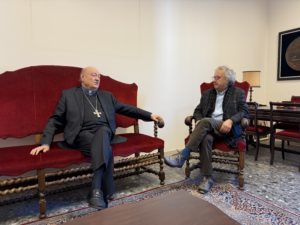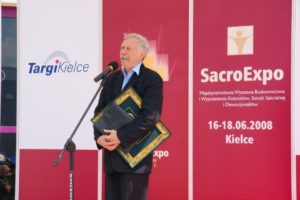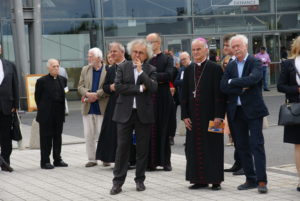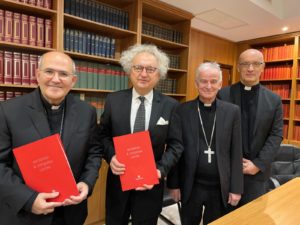 Cardinal Gianfranco Ravasi, former President of the Pontifical Council for Culture, emphasizes the importance of art in an interview with Targi Kielce. He addresses contemporary cultural challenges, highlighting the need to build bridges between believers and non-believers through his “Courtyard of the Gentiles” initiative, and stresses the importance of preserving identity and respecting diversity in a world dominated by modern communication techniques and media
Cardinal Gianfranco Ravasi, former President of the Pontifical Council for Culture, emphasizes the importance of art in an interview with Targi Kielce. He addresses contemporary cultural challenges, highlighting the need to build bridges between believers and non-believers through his “Courtyard of the Gentiles” initiative, and stresses the importance of preserving identity and respecting diversity in a world dominated by modern communication techniques and media
Cardinal, does art bring people closer to the Church?
Cardinal Ravasi: I would like to define art usinng the words of a great artist of the last century, Paul Klee, who defined art as follows: “Art does not represent what is visible, but what is invisible in the visible.”. This definition of art attempts to go deeper beneath the surface and could also be the definition of theology and even faith. It deals with the outer layer and history and looks for what lies deeper. And we write the Invisible, which is spelled with a capital letter because it is the sphere of the Divine. And it is in this sense I believe that art and faith have always been sisters the case in the history of Western culture. If we look at Poland, as well as the whole of Europe and the broadly defined West, we will see that biblical symbols, characters, stories, and motifs have become the subject of art. If someone enters a museum or an art gallery in Europe or the West in general, and knows nothing about the Gospels or the Bible, they will not understand most of the works on display because art and faith were deeply intertwined at that time. We want to achieve this today with the Per Artem Ad Deum award – to make art meet faith again.
The Targi Kielce SacroExpo has been attracting artists, creators and representatives of the Church for many years. What is the role of this event in promoting religious and spiritual art and creating a space for dialogue between culture and faith?
 Cardinal Ravasi: I believe this event lresults in such a meeting on two levels; the higher level, is achieved for example by the Per Artem Ad Deum award. It involves great performers, high-brow artists who prepare installations for the community, for great cathedrals, and for decorations. A very high level is achieved, sometimes also with the participation of great artists. However, there is a second level – the social level, the piety of society. Poland is unique in this sense, as is my home country, Italy where the social fabric, with its processions, piety, shrines, and religious objects, is an important element. Almost like a breath of faith, something holy that we must strive to protect and maintain its nobility rather than reduce to folklore. In this sense, Kielce can fulfil an essential function at both levels.
Cardinal Ravasi: I believe this event lresults in such a meeting on two levels; the higher level, is achieved for example by the Per Artem Ad Deum award. It involves great performers, high-brow artists who prepare installations for the community, for great cathedrals, and for decorations. A very high level is achieved, sometimes also with the participation of great artists. However, there is a second level – the social level, the piety of society. Poland is unique in this sense, as is my home country, Italy where the social fabric, with its processions, piety, shrines, and religious objects, is an important element. Almost like a breath of faith, something holy that we must strive to protect and maintain its nobility rather than reduce to folklore. In this sense, Kielce can fulfil an essential function at both levels.
Are you pleased that the new Dicastery will continue the Per Artem ad Deum award for Culture and Education?
Cardinal Ravasi: This is a thread that began when I was President of the Pontifical Council for Culture for many years. It is a golden thread because of the people involved. I am glad that it sees the continuation by my successor. I am also glad that the Per Artem Ad Deum award is associated with the Sacroexpo Exhibition in Kielce, a very significant event in Poland and at the European level. This unique space, the exhibition space, also includes culture in dialogue with the world of faith and faith in dialogue with the world of culture.
We were honoured to host Your Eminence twice at the SacroExpo Exhibition in Kielce. Your Excellency Cardinal – what are your memories associated with these visits? Were there any memorable and unique moments?
Cardinal Ravasi: These two visits were indeed special, also because of two exceptional figures from the world of culture. I would like to recall, apart from the architect Mario Botta, the award for Ennio Morricone. I think about the importance and significance of his music at an international level. Their music has enhanced many important films, such as Mission he created the original score. He created hundreds of musical pieces he was award for. I personally presented him with the award shortly before his death – the Gold Medal of the Pontificate from Pope Francis, because he wrote the Mass: Missa Papae Francisci in honour of Pope Francis. However, what I remember most from Kielce visit is the fact that he composed, performed and also conducted musical oratorio dedicated to John Paul II, which was an exceptional event. It was important to him too; he also mentioned this in conversations with me as an important moment, because he was a great admirer of John Paul II.
As an eminent cultural expert and long-time Pontifical Council for Culture president, what would you like to convey to contemporary artists?
Cardinal Ravasi: I would certainly like to tell them to constantly seek the beauty; the beauty as defined in some languages, including the language of the Bible, especially in Hebrew, the language of the Old Testament, but also in the New Testament. The same word signifies both beauty and good. In the Old Testament, this is the word tov, which means Good, beautiful.… and even useful. And in the New Testament, Jesus is presented in the Gospel of St. John as I am the good shepherd. as it is usually how it is translated. However in Greek I am the one who sent the kalos; where Kalos means beautiful. When St. Paul speaks of good works, he speaks of kala erga – beautiful deeds. Thus, I believe that art should represent not only aesthetics but also humanity in its most profound dimensions, which requires art to become a tool of morality or ethics. Otherwise art would be something else.
We live in times when religions, culture, and therefore art, must be able to solve a fundamental problem that was well expressed by the French philosopher of the last century, Paul Ricœur: We live in times in which bulimia of technical means – the technical means are enormous. The time we live in is accompanied by anorexia – anorexia means the lack – of goals, meanings, values.
That is why art, like faith and religion, should not only deal with technology, although technology is important but should also create spirituality, whether secular or non-religious.
Your Eminence is the creator of the “Courtyard of the Pagans” initiative, which promotes dialogue between believers and non-believers. Cardinal, is it possible to assess the impact of such initiatives on interpersonal relations today?
Cardinal Ravasi: As we can, unfortunately, see today, which was already the case in the past, but it is deepening; our culture is often a culture of conflict. Just look at the television debates, which are often aggressive just like politics, where we often observe something that resembles duels. The Courtyard of the Gentiles refers to the place in the temple in Jerusalem where Gentiles also dwelt. Although they also had their own gods, the Jews considered them atheists. The Courtyard was located next to the Court of the Jews, the Israelites. Thus, both groups could talk and enter into a dialogue, not in the form of conflict, but of a meeting. So they tried first to see what united them, and only then what divided them. Unfortunately, this is the hardest thing; it is easy to be tempted to view another person negatively. Let us consider, on the one hand, the problem of immigration, with all the problems that it obviously causes due to the diversity of cultures. Today we undoubtedly live in a multicultural, multireligious world; Europe will become diversified. So it is easy to succumb to fundamentalism, draw the sword, and reject the other person… I like to use music-related image, the metaphor of a duet. In music, a duet can be made of a soprano – a high voice – and a bass, singing together. But the soprano does not go an octave lower and the bass does not go out of tune; they sing together. Each sings with its own voice, therefore a Christian must preserve thei own identity, which is, unfortunately, disappearing in Europe. And on the other hand they must respect the different voice and listen to them, i.e. another person’s voice.
What other projects are you, Eminence currently working on?
Cardinal Ravasi: I no longer direct the Pontifical Council for Culture. I don’t have an assigned field, and while running the Courtyard of the Gentiles, I can be interested in many different topics. This is an institution that I founded and which I still direct; I am primarily interested in new fields, beyond art, culture and literature. I am particularly interested in music, in addition to science and technology, especially in three areas: genetics, for example DNA, surgery, etc. And then there’s neuroscience, with all the problems that arise here regarding AI, freedom, consciousness, and all those kinds of issues. Thirdly, artificial intelligence is a highly complex area that’s emerging, primarily around open-algorithm artificial intelligence, which means autonomous machines.
I am particularly interested in new means of communication, i.e., new languages, such as computer languages, especially in connection with their difficulties. Because when we think about what is happening on these networks… the violence, the obscenity, the dark web… At the same time, they could achieve much more through preaching the Gospel. I am particularly interested in two things – science and technology and information technology and communication, or digital culture. Who knows, maybe with these means, we will be able to build a bridge between believers and non-believers in the future. We’ll see.
This is what is important. We must remember about this … and I will say this now from the point of view of believers:
it is impossible to separate oneself and remain in the closed space of one’s own Church, a protected oasis.
We need to go out into the courtyard … where the world is in motion, using different languages and sometimes values and anti-values, including value negation.
Thank you for the conversation.
This year, the 26th Sacroexpo – Targi Kielce will become the place to present broadly defined religious and spiritual art, as well as traditional and modern industry solutions. From 2 to 4 June 2025, the Kielce exhibition and congress centre will be the meeting place for all those looking for inspiration and willing to keep up to date with the latest trends in this sector.
This year’s Sacroexpo at Targi Kielce is the Per Artem Ad Deum Award presentation arena.
 – In 2008, Professor Leszek Mądzik was awarded the Per Artem Ad Deum Medal during the International Exhibition of Church Construction, Church Fittings and Furnishings and Religious SACROEXPO – recalls Andrzej Mochoń, president of Targi Kielce. – He was awarded this distinction for his extraordinary ability for introducing spectators into life’s religious space of mystery and death, for artistic sensitivity and creation of the image theatre
– In 2008, Professor Leszek Mądzik was awarded the Per Artem Ad Deum Medal during the International Exhibition of Church Construction, Church Fittings and Furnishings and Religious SACROEXPO – recalls Andrzej Mochoń, president of Targi Kielce. – He was awarded this distinction for his extraordinary ability for introducing spectators into life’s religious space of mystery and death, for artistic sensitivity and creation of the image theatre




